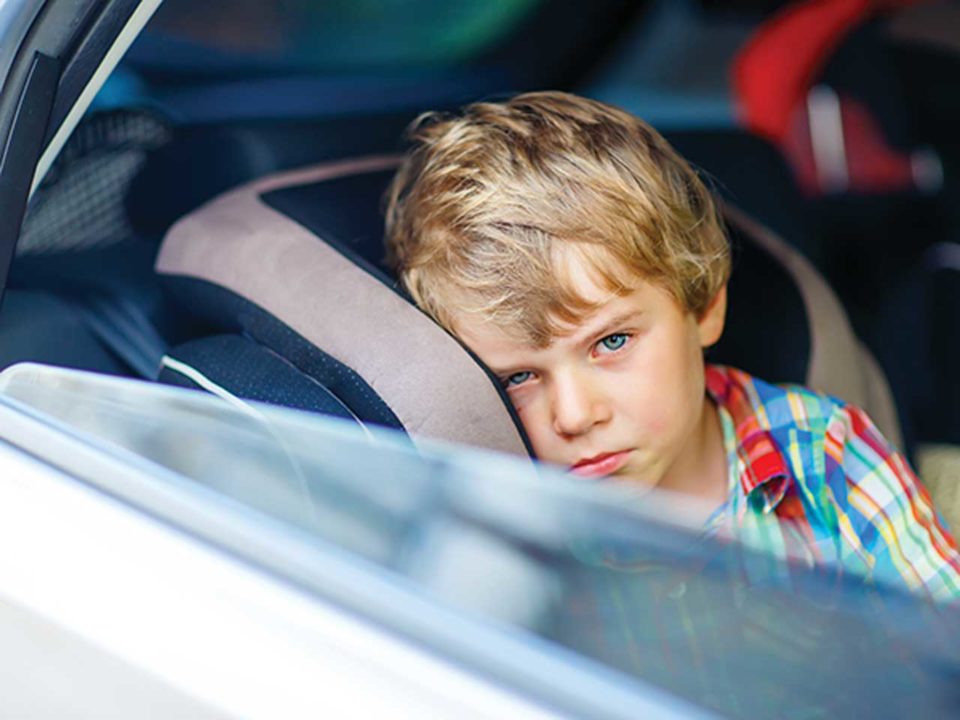Summer in Colorado is the season for winding car rides to mountain towns, wavy boat rides on reservoirs, and family outings to spin and drop on amusement park rides. And it’s all fun and games until someone barfs in the backseat or over the side of the tilt-a-whirl. Then the clean-up begins.
Prevalent in kids ages two to 12, motion sickness is no joy ride for anyone. Luckily, there are tricks to prevent it. Just being aware of the causes and triggers may help you prepare for your next family trip.
Causes and Symptoms of Motion Sickness
Car, boat, and airplane rides are common culprits of motion sickness, causing kids to feel nauseous, uneasy, and sweaty. Sometimes, with severe motion sickness, they may vomit. In other words, keep that barf bag handy.
Hilary Back, a naturopathic doctor and licensed acupuncturist at Back to Balance in Carbondale, says her own daughter would inevitably get sick and vomit on the car ride from Telluride to Carbondale as a young child.
Motion sickness originates in the brain, says Dr. Christine Darr, a pediatric emergency physician at HealthONE Rocky Mountain Hospital for Children in Denver. “Our brains receive numerous inputs to estimate our motion and spatial orientation of our heads. And sometimes [our brains] get information that makes it seem like we’re going in a circle.”
Darr adds that the anatomic basis for motion sickness is not well understood. But, you might find that motion sickness runs in the family. “There is a genetic component that makes some people susceptible to motion sickness,” she says.
While infants and kids younger than two don’t typically get motion sickness, for children who do suffer from it, the condition usually peaks at age nine and then decreases throughout adulthood. There aren’t specific studies about how common motion sickness is in children, says Darr, but roughly 20 percent of people (adults and children) will experience some component of motion sickness in their lifetime.
Prevention First
The key to managing motion sickness is to prevent it from happening in the first place. Not many things will help it go away once you’re feeling sick, says Darr. “Most of the treatment is focused on prevention.” Try these methods:
- Go Screen-free Don’t let motion sickness-prone kids read or look at screens like tablets or phones in the car.
- Eat Light Avoid feeding kids a big meal before going on a car ride or other rides that typically bring on symptoms.
- Look to the Horizon Older children who are of the right size may try sitting in the front seat of the car. Encourage children who need to be in the back seat for safety compliance to look out the front or side windows at the horizon or at distant stationary objects. “You want to be looking out the window at the horizon line,” says Back, adding that these tricks to establish balance are going to help.
- Choose Wisely On a boat, select seats to minimize motion sickness, such as the lower- or mid-ship seats. Choose forward-facing seats on a train or bus and try to sit over the front edge of the wing on an airplane, says Darr.
- Experiment Both Darr and Back suggest trying acupressure bands. A manufacturer called Sea-Band says the bands have been successful in decreasing motion sickness for children age three and older.
Once Symptoms Set In
Remedies don’t have to be complicated, says Back, who suggests sipping on ginger or peppermint tea to calm nausea. Children who are old enough can chew on peppermint gum or suck on ginger chews, she adds.
Drinking water might help, but keep in mind that drinking an excessive amount of fluids could cause a child to feel more sick. “Ginger ale and Coke are both anti-nausea treatments, yet overall aren’t good for you,” says Back. Though the drinks are high in sugar and contain other problematic ingredients, she admits that they can be helpful in a pinch.
“One of my first go-to remedies for kids or adults who are getting chronic motion sickness is cocculus,” says Back. Cocculus indicus (30c) is a homeopathic remedy that comes in pellet form that you dissolve under your tongue. It’s available at stores that sell homeopathic products and it is safe for all ages, says Back.
A check-in with your pediatrician about over-the-counter or prescription medications may also be helpful. Motion sickness is one of those health issues that parents don’t talk about with their pediatrician because it can be a fleeting illness. “A lot of people don’t bring it up unless it’s severe and they get sick,” says Darr.
Children ages two to 12 may take dimenhydrinate, which comes in a children’s formula under the brand name Dramamine. Benadryl can also help, and can be used by children age six and older, or in children ages two to five, if directed by a doctor. A doctor may also prescribe Scopolamine patches, worn behind the ear, for children age 12 and older. All these medications cause drowsiness, so balance the potential for sleepiness with other activities planned later in the day.
With these prevention methods and remedies, hopefully the only effects of motion you’ll see from your kids will be joy and laughter. And your whole family will be able to keep moving to the next stop on your vacation.
Common Treatments for Motion Sickness
- Ginger tea, chews, candies, or ginger ale (in moderation): Ginger has anti-nausea properties. All hard candies can present a choking hazard, so be aware of these risks with younger children.
- Cocculus indicus: Also called Indian cockle. Comes in pellet form that you dissolve under your tongue. Available at stores that sell homeopathic remedies.
- Acupressure bands: Apply pressure at the P6 acupressure point on the anterior wrist. Available online and at some retail stores.
- Dramamine and Benadryl: Antihistamine medications that can also cause drowsiness. Available over the counter in children’s formulas.





